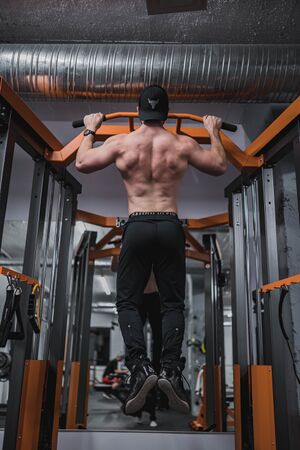Chin Up Exercise
Original Editor - User Name
Top Contributors - Lucinda hampton, Chelsea Mclene and Kim Jackson
Introduction[edit | edit source]
A chin ip is an exercise in which one hangs by the hands from a support (such as a horizontal bar) and pulls oneself up until the chin is level with the support. Such an exercise done with the palms facing inward (a pull up is done with the palms facing outward).[1]
- Most upper body exercises will help with chin-ups. Lat pulldowns, rows, and bicep curls will all be beneficial if the ultimate goal is achieving a chin-up with correct form.
Prime Mover[edit | edit source]
Latissimus dorsi (lats) is the most powerful pulling muscle in your back, and during a chin-up, it’s the primary mover.
Synergists[edit | edit source]
A series of powerful muscles in the upper and lower arms kick in to help accomplish this motion. These include
Biceps brachii, brachioradialis and brachialis.
Part of your triceps also helps to stabilise your arm[2].
The infraspinatus, teres minor and teres major also assist your lats when doing a chin-up.
The lower trapezius is involved in the mobility and stability of the scapula (shoulder blade) during the chin up.
The pectoralis major activates as you pull yourself up and over the bar, its contribution is not nearly as much as other muscles eg the latissimus or biceps.
The external abdominal oblique and erector spinae function to stabilises the trunk during a chin up. They are are required to stabilise the body’s core to enable the body to be lifted as one solid structure.[2]
Good Form[edit | edit source]
Technique in all exercises in key.
- Perform smooth reps
- The arms should be straight at the start of each rep but not a dead hang.
- Keep your glutes and abs tight. This helps you stop swinging.
- No half reps. When you can no longer get a full rep, the set is over
- Avoid extreme grips positions (super-narrow or super-wide). For chin-ups (palms facing you), try one hand space inside of a shoulder-width grip. For pull-ups (palms away from you), try one to two hand spaces outside of shoulder-width.
- Vary your grip style to keep the joints healthy. Rotate between grip variations every couple of months (under-hand, over-hand, neutral). If one particular grip style feels uncomfortable, don’t do it.[3]
Chair Assisted Chin Up[edit | edit source]
Because the pull-up is an advanced exercise that not all lifters can do, there is a easier version to start with:
Position a chair so it faces you when you are hanging from the pull-up bar. Position it so the front edge of the seat is almost directly under the bar. Grab the pull-up bar with an overhand, shoulder-width grip and place one foot on the seat of the chair. Allow the other leg to hang down toward the floor. Press through your foot as you pull yourself up. Only provide as much assistance as you need to complete the pull-up. Focus on pulling with your upper body, specifically your back muscles[4].
Resources[edit | edit source]
- bulleted list
- x
or
- numbered list
- x
References[edit | edit source]
- ↑ Merriam Webster Chin up Available: https://www.merriam-webster.com/dictionary/chin-up(accessed 1.1.2022)
- ↑ 2.0 2.1 AMM Fitness Chinups Muscles Worked Available: https://www.ammfitness.co.uk/information-advice/chin-ups-muscles-worked(accessed 1.1.2022)
- ↑ Ripped Body The ultimate chin up work out Available: https://rippedbody.com/chin-up-pull-up-progress-guide/ (accessed 1.1.2022)
- ↑ Live Healthy Assisted chin ups with a chair Available: https://livehealthy.chron.com/assisted-pull-ups-using-chair-7355.html(accessed 1.1.2022)







